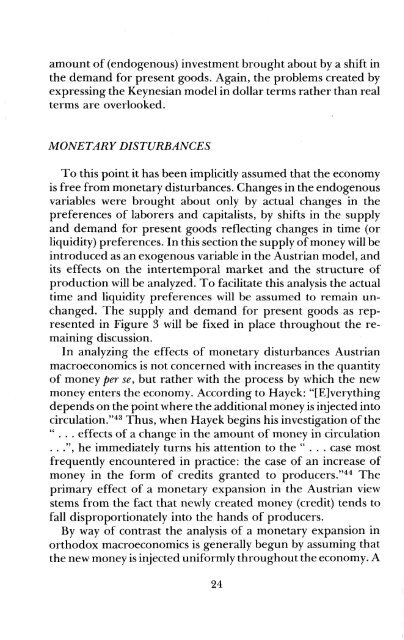Austrian Macroeconomics - Ludwig von Mises Institute
Austrian Macroeconomics - Ludwig von Mises Institute
Austrian Macroeconomics - Ludwig von Mises Institute
Create successful ePaper yourself
Turn your PDF publications into a flip-book with our unique Google optimized e-Paper software.
amount of (endogenous) investment brought about by a shift in<br />
the demand for present goods. Again, the problems created by<br />
expressing the Keynesian model in dollar terms rather than real<br />
terms are overlooked.<br />
MONETARY DISTURBANCES<br />
To this point it has been implicitly assumed that the economy<br />
is free from monetary disturbances. Changes in the endogenous<br />
variables were brought about only by actual changes in the<br />
preferences of laborers and capitalists, by shifts in the supply<br />
and demand for present goods reflecting changes in time (or<br />
liquidity) preferences. In this section the supply ofmoney will be<br />
introduced as an exogenous variable in the <strong>Austrian</strong> model, and<br />
its effects on the intertemporal market and the structure of<br />
production will be analyzed. To facilitate this analysis the actual<br />
time and liquidity preferences will be assumed to remain unchanged.<br />
The supply and demand for present goods as represented<br />
in Figure 3 will be fixed in place throughout the remaining<br />
discussion.<br />
In analyzing the effects of monetary disturbances <strong>Austrian</strong><br />
macroeconomics is not concerned with increases in the quantity<br />
of money per se, but rather with the process by which the new<br />
money enters the economy. According to Hayek: "[EJverything<br />
depends on the point where the additional money is injected into<br />
circulation."43 Thus, when Hayek begins his investigation ofthe<br />
" ... effects of a change in the amount of money in circulation<br />
...", he immediately turns his attention to the" ... case most<br />
frequently encountered in practice: the case of an increase of<br />
money in the form of credits granted to producers."44 The<br />
primary effect of a monetary expansion in the <strong>Austrian</strong> view<br />
stems from the fact that newly created money (credit) tends to<br />
fall disproportionately into the hands of producers.<br />
By way of contrast the analysis of a monetary expansion in<br />
orthodox macroeconomics is generally begun by assuming that<br />
the new money is injected uniformly throughout the economy. A<br />
24

















